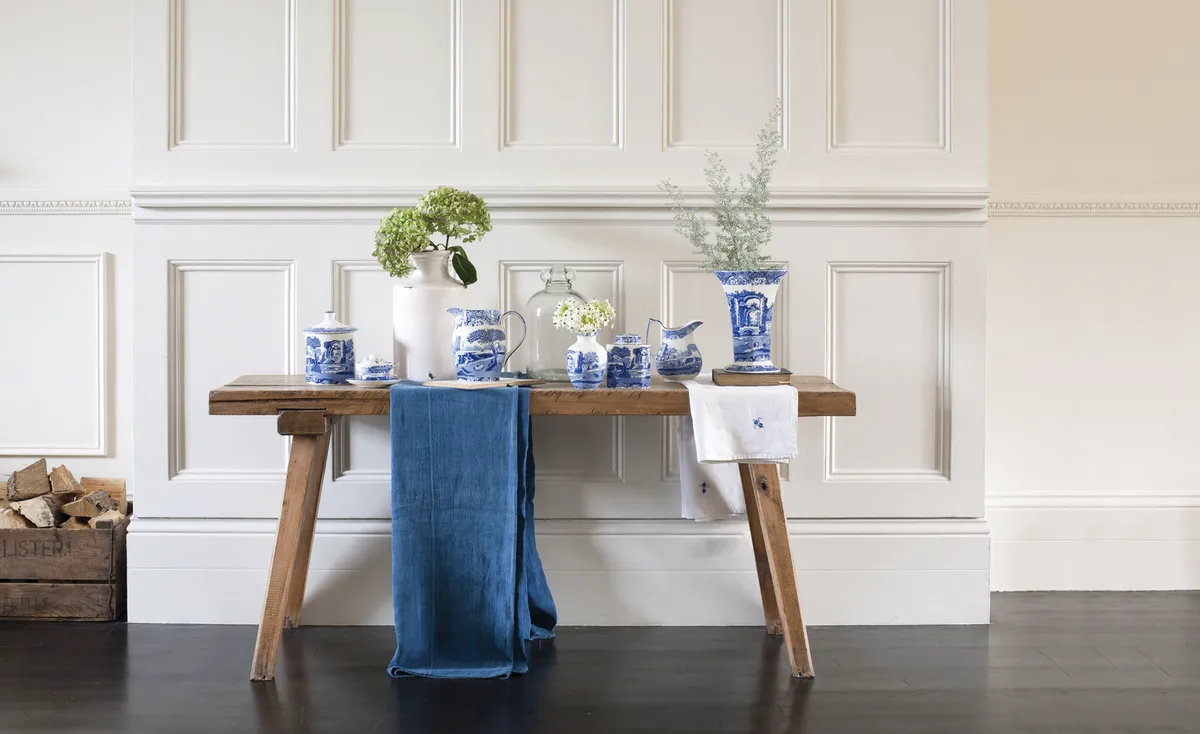With its rich cobalt colours and classic rural scene, Spode’s Blue Italian print is the epitome of blue and white porcelain. The design was launched more than 200 years ago to immediate popularity, and its star has continued to rise over the decades – it remains a bestseller to this day. So how did this distinctive pottery from Stoke-on-Trent go on to become a timeless icon in homes across the world?

1
What's the history of Spode's Blue Italian design?
The Blue Italian design was launched by Josiah Spode II in 1816, and this decorative vignette provided the perfect showcase for his father’s revolutionary blue underglaze transfer printing process. It depicts a classic Italianate landscape – although the origins of the scene remain a mystery, as no single place in Italy seems to match the various elements. Nevertheless, it brought huge success for Spode and in the 1930s one catalogue recorded over 700 different items available.‘It has certainly proved long lasting, perhaps due to its unique combination of European andAsian design – the classical Italian scene coupled with the Imari- inspired border,’ says Paul Holdway, former Head Engraver at Spode, and one of the Trustees of the Spode Museum Trust. ‘This, along with the fine quality of its hand engraving and use of cobalt blue printing, was a winning formula.’
2
How was Spode founded?
Josiah Spode I’s contribution to porcelain design made him a key figure of the Industrial Revolution and his legacy is still felt today. Born in Stoke-on-Trent in 1733, by 1749 Spode had worked with the potter Thomas Whieldon, and in 1770 he established his own factory in his home town. It was around 1783-84 that his technique for underglaze transfer printing was credited with reinvigorating the British pottery industry, setting a new standard for blue and white ceramics. Spode died suddenly in 1797, and under his son, Josiah Spode II – a talented, ambitious potter himself – the company continued to go from strength to strength. Indeed, it was Spode II who introduced theBlue Italian range.The company was eventually bought by theCopeland family, then in 2009 it was acquired by the Portmeirion Group. Through all this, Spode has held on to its tradition of quality materials and craftsmanship, cementing its name as a British byword for excellence.

3
How to style Spode Blue Italian
Elegant yet versatile
The enduring appeal of Spode’s Blue Italian design is easy to understand. Despite its classical subject matter, the imagined landscape with a ruined arch has a timeless charm that works in both traditional and contemporary settings – the busy scene in cobalt blue looks wonderful against a bold contrasting colour and completely at home on the worn pine of a Welsh dresser.



4
Buying advice: how to shop for antique Spode china and porcelain
Spode embodies a quintessentially British style and remains eminently collectable today. Through theyears there have been various different Spode and Copeland-Spode marks and stamps, which correspond to the dateof manufacture. These can help indicate the authenticity and age of a piece, so some research into the marks will help prospective collectors (Spode & Copeland Marks and Other Relevant Intelligence by Robert Copeland is an excellent resource). Some of the very earliest Spode works, however, remain unmarked and can be harder to identify.
The good news is that Spode antiques tend to be widely available, so it’s not difficult to start building a collection. 'You can buy from most antiques centres,’ explains Paul Holdway. ‘And even places such as eBay. Plus, there is a large collection at the Spode Museum Trust Heritage Centre in Stoke, located on the former Spode factory site.’ This is an especially appealing place to start if you want to learn more about the company.
Try to seek out pieces that are in good condition. Paul recommends a careful check for damage before you buy: ‘Look for things like nips and chips to the edges, and also hairline cracks or discolouration through crazing to the body.’
With such a diverse catalogue of designs, you will no doubt have your own favourites among Spode’s patterns, but there are some that command more attention from aficionados.
‘Pre-1800 chinoiserie or Willow designs, animals, fables, floral designs, Indian sporting and Greek patterns are all much sought after by collectors,’ suggests Paul. Unusual shapes or colours are also likely to elevate the value of
an item.
Prices for Spode antiques can vary enormously, depending on the age, condition, style and design of a piece, and as a guide you might expect topay from around £5 for a small plate to several thousands of pounds for a large item, such as a footbath or garden seat.
